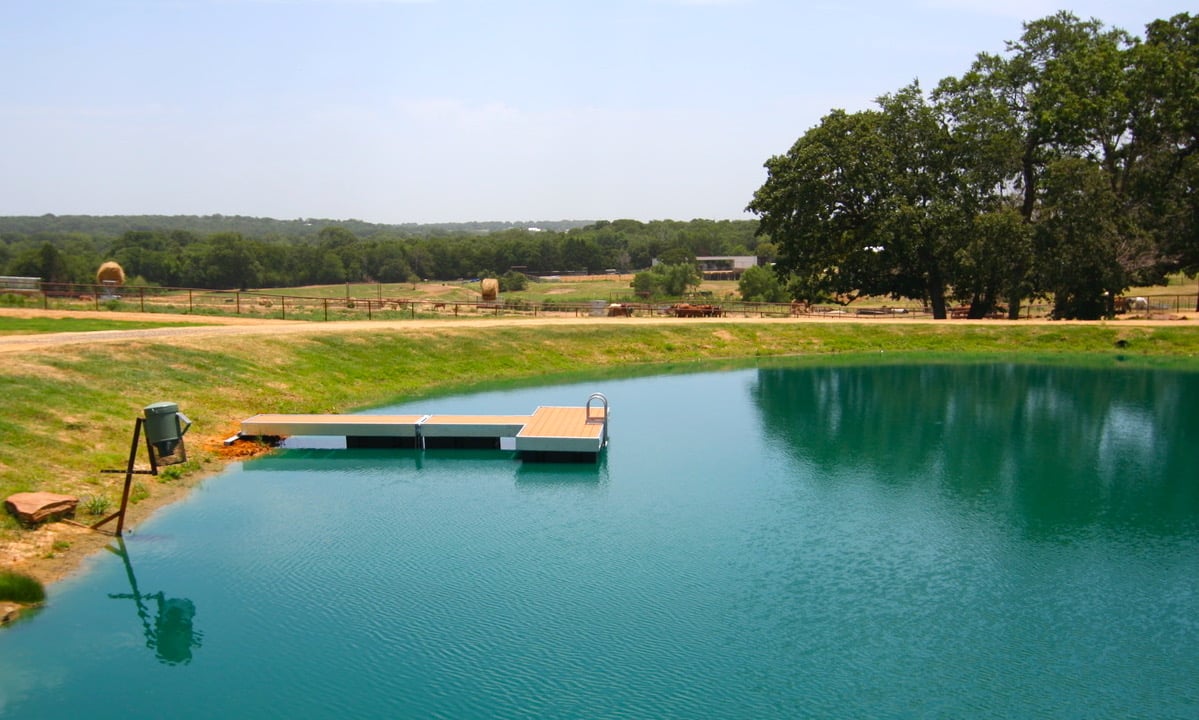Fertilizer and pond dye are both great pond management techniques for reducing water clarity, but there are specific reasons to choose one over the other.
Fertilizer vs. Pond Dye: What's the Difference?
When it comes to pond management, sometimes there's confusion about pond dyes and fertilizers, their respective uses, and key differences. The confusion stems from misconceptions about water clarity and the fact that both dye and fertilizer are techniques used to reduce water clarity.
So, first, it is important to understand that if the water in your pond is too clear, you can have high amounts of vegetation in your pond, and your bass production may struggle. The biologists at Pond King have a few quick tips if you’ve asked yourself, “Could my pond be too clear?"
For now let's discuss why and when you would choose to use fertilizer or pond dye to reduce visibility in your private fishery.
Why Fertilize a Lake?
Fertilizer is a resource that we primarily use to help customers enhance their bass production in their lakes that are at least 2-acres in size.
What Type of Pond Fertilizer is Recommended?
The fertilizer that we use here at Pond King is Pond Pro 10-52-4. These numbers stand for 10% nitrogen, 52% phosphorous, and 4% potash. This fertilizer is a granular fertilizer that is 100% water-soluble, which means the fertilizer will dissolve completely before getting trapped in the sediment on the lake's bottom.
How Much Fertilizer Will I Need for a 1 Acre Pond?
Four pounds of this fertilizer treats a one-acre pond, although we do not usually recommend fertilizing any body of water that is smaller than 2 acres. The combination of nitrogen and phosphorus causes a planktonic bloom to occur, which is the base of the food chain.
Benefits of Pond Fertilization
Increasing the bottom of the food chain helps increase the production of baitfish in your pond. Increasing the baitfish production in your pond gives your bass more forage to feed on, contributing to your bass's growth rates. Fertilization is a great management strategy for increasing bass production, especially if you're trying to raise trophy-class bass.
Grow Bigger Bass!
Another benefit of this fertilizer is that it inhibits your pond's water clarity. The optimal clarity of a bass fishery is 18-24". Bass do not feed as effectively when the water clarity is much less than 18 inches or greater than 24 inches. Bass are ambush feeders; they sit tight to cover and 'ambush' the prey as they swim by. The reduced water clarity allows the bass to hide from the baitfish, so it's easier to catch the next meal.
Keep Your Vegetation Under Control
The reduced clarity can also help with vegetation issues. Ponds that are too clear allow sunlight to penetrate to the pond floor, promoting vegetation growth. If the pond is clear enough to allow sunlight to reach the bottom at greater depths, vegetation can quickly spread and become hard to control.
Fertilization helps because whenever the algae bloom begins, the water will turn a greenish tint from the increase in plankton, thus decreasing the visibility and blocking the sunlight from reaching the pond floor.
Why Dye a Pond?

Typically, we use pond dye for aesthetic reasons because it helps reduce water clarity, preventing vegetation growth, but is also pleasing to the eye.
What is a Good Pond Dye?
The dye that we use and recommend here at Pond King is called Aquashade. It comes in one-gallon containers and treats a one-acre pond.
Pond Dye Application Process
Pond dye is very easy to apply. You simply walk around the edge of the pond and pour it into the water. The dye spreads itself throughout the pond. It is easiest if you do it on a day that the wind is blowing.
Stand in one area on the upwind side of the pond and pour it into the water, letting the wind help spread it to the rest of the pond. Adding dye to your pond makes a significant difference in the clarity of the water, which helps prevent and maintain vegetation growth without having to do much extra work or adding a lot of chemicals to your pond.
Is Dye Safe for the Fish Living in My Pond?
Many people ask if the added dye is harmful to the fish and the answer to that question is no. The dye dilutes fast enough that it has no harmful effects on the fish in your pond. The dye will need to be reapplied over time as it begins to break down.
Know the Right Situation for the Proper Application!
As you can see, dye and fertilizer are both very useful in reducing water clarity to help control vegetation but should be used in different situations. Fertilizer should only be used in bodies of water that are at least 2-acres and where the focus is bass production. Pond dye is recommended to improve the aesthetics for bodies of water that are smaller than 2-acres.
Let the Pros at Pond King Help with Your Pond Solutions!
If you have any questions about which one would be better for your pond or lake, or any other questions, come by and visit with us at our location in Gainesville, Texas, give us a call at (940) 291-2576, or feel free to contact us directly. We'll be happy to help!
See y'all down at the pond!




